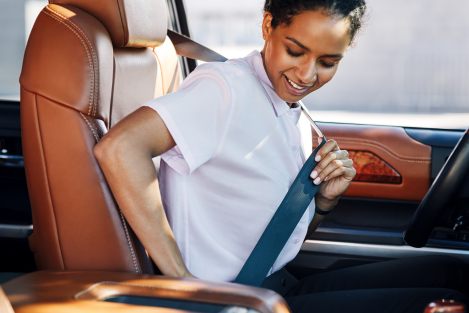
Written by Kayla Jane Barrie Updated on Feb 24, 2025 5 mins read

Seat belts are essential for safety in any vehicle and are required by law in Ontario. It's crucial to understand the rules and consequences of not wearing seat belts.
In 2022, the percentage of passengers killed without seatbelts decreased, while the percentage of unbelted drivers increased slightly. However, the percentage of both passengers and drivers seriously injured without seatbelts decreased - the proportion of passenger serious injuries attributable to the lack of seatbelt usage decreased from 21.3% in 2021 to 17.2% in 2022, representing a 19% reduction.
This blog will talk about the laws and fines around seatbelts and how to wear them properly.
In Ontario, all vehicle occupants must wear seatbelts.
Drivers must ensure passengers under 16 wear seatbelts, passengers 16 and older are responsible for their own seatbelts, children under 8, weighing less than 36 kg, or shorter than 145 cm, need a child car seat or booster seat.
In 2006, a new law for seatbelt safety was passed to keep drivers and passengers safe on the road. Section 106 of the Highway Traffic Act covers the laws regarding seatbelts in the province. Here is a look at the key points:
Seat belt assembly must not be removed or altered
106. (1) No person shall drive on a highway a motor vehicle in which a seat belt assembly required under the Motor Vehicle Safety Act (Canada) at the time that the vehicle was manufactured or imported into Canada has been removed, rendered partly or wholly inoperative, modified so as to reduce its effectiveness or is not operating properly through lack of maintenance.
Use of seat belt assembly by driver
(2) Every person who drives on a highway a motor vehicle in which a seat belt assembly is provided for the driver shall wear the complete seat belt assembly as required by subsection (5).
Use of seat belt assembly by passenger
(3) Every person who is at least 16 years old and is a passenger in a motor vehicle on a highway shall,
(a) occupy a seating position for which a seat belt assembly has been provided; and
(b) wear the complete seat belt assembly as required by subsection (5).
Driver to ensure young passenger uses seat belt assembly
(4) No person shall drive on a highway a motor vehicle in which there is a passenger who is under 16 years old unless,
(a) that passenger,
(i) occupies a seating position for which a seat belt assembly has been provided, and
(ii) is wearing the complete seat belt assembly as required by subsection (5); or
(b) that passenger is required by the regulations to be secured by a child seating system or child restraint system, and is so secured
If convicted of failing to wear a seatbelt, you could face fines ranging from $200 to $1,000, along with two demerit points added to your driving record. Additionally, you can be fined for having a broken seatbelt, even if it is not in use when stopped by a police officer. Getting a ticket for not wearing a seatbelt can increase your rates.
As the driver of a vehicle, it is crucial to adhere to the following safety measures:
Wearing a seatbelt properly is crucial to protecting yourself and others. Here are a few tips to keep in mind:
There are a few exemptions to the seatbelt rules, according to the Ontario.ca website, such as:
In Ontario, a violation for not wearing a seatbelt may result in a fine of up to $1,000. Furthermore, individuals may incur two demerit points on their driving record, potentially influencing premiums and engendering additional repercussions if these points accumulate.
Since 2006, Ontario has enforced the "one person, one belt" rule, requiring each vehicle occupant to have their own seat and safety restraint.
Yes, in Ontario, it is the law for all passengers, including those in the back seat, to wear a seatbelt. Passengers who are 16 and older are responsible for wearing their seatbelt, while drivers must ensure that passengers under 16 are properly buckled up. Failing to comply can result in fines.
Ontario's seatbelt laws are not just about avoiding fines; they're about saving lives. The next time you get in your car, remember that wearing your seatbelt could mean the difference between walking away from a crash or suffering serious injuries. Stay safe, buckle up, and make sure everyone in your car does the same.
| Categories | Auto |
|---|---|
| Tags | Driving Tips |
Read our insurance blog to get helpful tips, information and news.
Has your car been totalled in an accident? Is your car a write off? Learn about vehicle write offs for a total loss insurance claim.
Get the facts on Toronto's auto theft problem. We break down the data, reveal the most-stolen vehicles (including the Honda CR-V and Lexus RX 350), and show which neighbourhoods are most affected.
Dive into the world of auto theft with our blog on the most stolen cars in Canada. See the most stolen cars across Canada, including provincial lists for Ontario and Quebec, and learn how high-risk models can affect your car insurance premiums.
Drive safe this winter! Check out these tips for driving in snowy and icy conditions in Ontario. Get other helpful info and FAQs on winter driving.